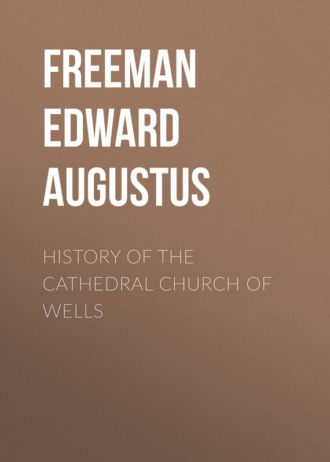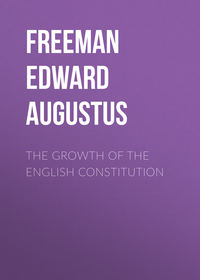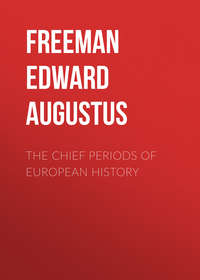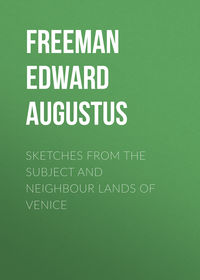 полная версия
полная версияHistory of the Cathedral Church of Wells
Thus the Chapter of Wells gradually became, like other Chapters, no longer a body of clerks headed by the Bishop, but a separate corporation subject only to the Bishop's visitation. But this was not the only instance of the spirit of local and corporate isolation which is supplied by the history of capitular bodies. Besides the Chapter becoming an independent corporation aggregate, we have seen that each Canon became for some purposes a separate corporation sole, independent alike of the Bishop and of his brother Canons. Nor did this independence always affect matters of property only. The notions of property and jurisdiction were closely connected in the ideas of those times. It followed that in many cases the parishes where either the Chapter or any particular Prebendary had property, those especially where they possessed advowsons or rectories, became exempt from the ordinary jurisdiction of the Bishop, and were placed under the peculiar jurisdiction of the Chapter itself or of the particular Prebendary.67 My friend the Sub-Dean can bear witness that, though his rectory and advowson have gone elsewhere, he still retains, or very lately retained, some small remnants of ecclesiastical jurisdiction among my neighbours at Wookey. But the spirit of corporate independence went further still. We have not yet come to the days of Vicars and Chantry-priests. But we shall find that even these purely subordinate officers, mere assistants to the Canons as regards their ecclesiastical duties, became perfectly independent corporations as regards their temporal possessions.
I have dwelt at length on the changes wrought by Bishop Robert in the constitution of the foundation, because they were the beginning of the constitution as it still exists, and because these changes of Bishop Robert's were simply one example out of many of the changes which were going on everywhere. The constitution which was assumed by the church of Wells was essentially the same as the constitution which was assumed by all the secular cathedrals, some a little sooner, some a little later. The exact number and functions of the officers are not everywhere precisely the same. But we everywhere find the Precentor, the most absolutely indispensable functionary of all, and we commonly find the Dean, Chancellor, and Treasurer. The distinction too between the property of the Chapter as a body and the property of separate Prebendaries is common to all the cathedrals of the Old Foundation.
I now come to what Bishop Robert did with regard to the fabric of the church. I have already said, while speaking of Robert's building at Bath, that our two chief accounts, earlier and later, do not exactly agree as to the extent of his works at either place. The earlier account seems to assert a complete rebuilding from the ground; the later implies only a thorough repair of a church which had become ruinous and dangerous.68 As all the work of this date at Wells has vanished, it is impossible to say for certain how the case really stood, but at all events Robert's repair must have been very extensive, as it was followed by a reconsecration of the church. But what I want you specially to remark is this, that the church which Robert either repaired or destroyed in order to rebuild must have been the Old-English church, one can hardly venture to say the church of Ine, but very possibly the church of Eadward the Elder. The old church thus lasted, certainly to the middle of the twelfth century, perhaps even some way into the thirteenth. Now at either of those times large churches earlier than the Norman Conquest must have been almost as rare in England as they are now. The Norman and other foreign Prelates, who were thrust into English Bishopricks and Abbeys, had almost everywhere rebuilt their minsters in the newly imported style long before the time of Robert's episcopate. But it is plain that such was not the case at Wells. The acts of Gisa and John of Tours are so fully recorded that, if either of them had rebuilt the church of Wells, we could not fail to have heard of it. Gisa, we know, thought poorly of the building,69 but he does not say that he did anything to improve or enlarge it. His architectural works were all devoted to the accommodation of the Canons on his new system. And it is plain from the account of his burial that he was buried in the same church in which his predecessor lay, which it therefore follows that he had not rebuilt. John of Tours, I need not say, was not likely to rebuild the church of Wells. In short, we have no mention of the actual fabric of the cathedral till we come across this description of its dangerous and ruinous state in Robert's time. The Old-English church was therefore still standing, and, if Robert merely repaired and did not wholly rebuild, parts of it must have been standing down to the great rebuilding under Jocelin. Perhaps we may be the more inclined to think that this was the case, when we see how soon Robert's work was done, and when we remember how utterly his work was swept away so soon after his own time. The church was consecrated in the presence of three other Bishops, one of whom, Robert, Bishop of Hereford, died in 1148.70 Our Robert therefore had at the outside only thirteen years of the stormy reign of Stephen for the rebuilding of his church at Wells, and that at a time when he was also occupied with his architectural works at Bath, and with his efforts to recover the lost property of the Canons. At all events, whatever was the exact extent of his work, it is certain that not a single bit of detail of his age is to be seen in the present church; a single stone with Norman mouldings, which must have formed part of Robert's building, is built up in the house which was lately restored by Mr. Parker. That is literally all; in the church itself I think I can show one small bit of masonry of Robert's age, but it is merely masonry, without any ornamental work. It is seldom that one of the massive piles of that day has so utterly gone, without leaving any trace of itself. But it is easy to call up before our eyes what the church of Robert must have been. It was small compared with the great Romanesque minsters of Peterborough, Ely, and Norwich, or with its own rival at Bath. The present building is one of the very smallest of the original cathedral churches of England, and, as it stood in Robert's day, it must have been much smaller than it is now. The western limb was most likely of its present length; the eastern limb was very much shorter than it now is, containing probably only one or two bays and the apse. The choir – the place for the stalls – if not actually placed in the western limb, was under the central tower, the usual place for it in Norman minsters. It has indeed struck me that what Robert did was perhaps mainly to rebuild and enlarge the choir and presbytery, – a change which the increase in the number of the Canons would make needful, and which, as changing the site of the high altar, would call for a fresh hallowing of the building. In this case it is quite possible that the ancient nave may have remained substantially untouched down to the building of the present church. As for the style of Robert's building, whatever he built or added was of course built in the fully developed Norman style of the middle of the twelfth century, somewhat less massive, somewhat more highly enriched, than the church of John de Villulâ at Bath is likely to have been. But the style was essentially the same; the church of Eadward at Westminster was still the great model for English buildings;71 it is not likely that the pointed arch found its way, even as a purely constructive feature, into any part of the church of Robert. If the nave or any other considerable part of the ancient minster really survived, it would have been most curious to trace the way in which the architect, like the architects of Le Mans and of Saint Remigius at Rheims, doubtless strove to throw a coating of the more refined Romanesque of his own day over the still living body of the old primitive building. But on these matters we cannot get beyond fairly probable conjecture. Whatever stood before the days of Robert, whatever was built in the days of Robert, has utterly vanished. Still there does seem every reason to believe that the ancient church of Wells, a church most likely of the tenth century, remained at least to the middle of the twelfth century, and that large portions of it were not improbably standing even in the thirteenth.
The episcopal reign of Bishop Robert has thus occupied a large part of our time. Nor has it done so unworthily, for his episcopate is the most important of all in the constitutional history of the Church of Wells; and, though all Robert's architectural works happen to have perished, yet his episcopate must have been almost equally important with regard to the material fabric. We may pass more lightly over the time of the two Bishops who came between the first great founder Robert and the second great founder Jocelin. Their time is a most important time in the history of the see of Bath and Wells; it is the most important of all times in the later history of the Church of Glastonbury; but it provides but little matter bearing on the history of either the fabric or the constitution of the Church of Wells. Bishop Robert died in 1166, and the see remained vacant for seven years. The next Bishop, Reginald, founded several new prebends,72 but I do not find any mention of the fabric in his time. Then came the famous Savaric, the last of our Lotharingian Prelates, whose detailed history belongs in a special manner to Professor Stubbs.73 His great object, as we all know, was to annex the Abbey of Glastonbury to the Bishoprick, and to make Glastonbury a third, or perhaps rather the first, cathedral church of the Diocese.74 The controversy which arose about this matter fills up the whole of his episcopate, and part of that of his successor, Jocelin, who was Bishop from 1206 to 1242. For a short time Glastonbury, much against the will of its own monks, remained an episcopal see, with the Bishop for its Abbot, and Jocelin himself signs the Great Charter by the title of Bishop of Bath and Glastonbury. One might have thought that this change was one which tended still more to the lowering of the position of the Church of Wells. But we may perhaps infer that it was not so taken, as we find the Dean and some of the Canons of Wells acting zealously on the Bishop's side in the course of the long dispute.75 In the end, as is well known, the monks of Glastonbury gained their point at the expense of considerable sacrifices. Jocelin gave up his claims over the Abbey; the Bishop of Bath and Wells ceased to be Bishop and Abbot of Glastonbury, and the minster of Glastonbury ceased to be a cathedral church. It became once more simply a monastery governed by its own Abbot, as it had been for so many ages. On the other hand, the monks of Glastonbury had to buy their independence by the surrender of several manors and advowsons; and, though the Bishop ceased to be Abbot, yet he retained a more efficient right of visitation over the Abbey than Bishops could commonly retain over monasteries so great in wealth and dignity.76 This agreement was made in the year 1218, and from that time till Jocelin's death in 1242, it would seem that his chief attention was given to the rebuilding of the fabric of the church of Wells, to some further changes in the constitution of the Chapter, and to other good works in the city. He could not have begun his works at Wells before the year 1211; for the first five years of his episcopate were spent in banishment under the tyranny of John.77 Jocelin was a Wells man in every sense of the word. As he is called Jocelin of Wells, and as his brother Hugh, Bishop of Lincoln, is called Hugh of Wells, both were doubtless natives of the city, and Jocelin had been a Canon of the Church before he became its Bishop. He is a memorable man indeed in our local history; he may be called the creator of the cathedral as it now stands, he put the last finishing touches to the capitular constitution devised by Robert, and he also began another of our institutions which has lasted to our own time, I mean that of the Vicars. With regard to the fabric, I now come upon ground which Professor Willis has made his own. As many of you doubtless remember, he has twice lectured on Wells Cathedral: once in 1851, when the Archæological Institute at their Bristol meeting paid a hurried visit to Wells; and again in 1863, at the meeting of our own local Archæological and Natural History Society, an honour, let me tell you, of a very rare kind, and which I believe has not been granted to any other local society. Now, if we had Professor Willis's lecture as he delivered it, there would be little else for any future historian of the fabric to do except to make spoil of what the Professor said. But unluckily, the great work of which this and all other Professor Willis's lectures of the same kind were to form parts has not yet appeared, and I greatly fear that it never will appear. We have therefore to draw our own recollections, helped by the report in our own Society's Proceedings, 1863, which is at least fuller and more accurate than that in the Bristol volume of the Institute. I shall therefore, in what I have to say as to architectural facts, follow Professor Willis as nearly as I can, though I shall have to make more use of my own light than I need have done if I really had the Professor's lecture before me. I speak thus of architectural facts, with regard to which he who follows Professor Willis will seldom go wrong; as for matters of taste and opinion, architectural or otherwise, I hold myself independent of Professor Willis as of every other man. But I should add that I have not had, like the Professor, the advantage of a diligent study of the manuscript documents in possession of the Chapter. I once glanced at them in company with Professor Stubbs, and that is all. When these documents are printed, as all documents of the kind ought to be printed, I hope I may be able to make good use of them; but while they are shut up in manuscript they are useless to me. Searching into manuscripts is a special gift, one which Professor Willis and Professor Stubbs, and some nearer to ourselves, possess in the highest degree, but it is a work for which I have neither time nor inclination.
Let us now look, in a general historical way, without attempting to enter into any very minute detail, at the church of Wells, as it was designed and begun, if not absolutely finished, during the long episcopate of Jocelin. That episcopate reached over twenty-four years from the settlement of the Glastonbury controversy, over thirty-six from Jocelin's first consecration. That any part of the church is older than Jocelin I see no reason to believe; but if anybody holds that the porch may be a little earlier than his time, I will not dispute against him. The church of Jocelin, thus understood, takes in the nave, the transepts, and what is now the choir proper, that is, the three western arches of the eastern limb. It takes in the three towers, up to the point where they rise above the roof of the church, but no higher. With the present presbytery, that is, the three eastern bays of the eastern limb, with the Lady chapel and the other small eastern chapels, with the Chapter-house and the tops of the towers, we have as yet nothing to do. Now within these limits, that is, between the west door and the Bishop's throne, I think that every one of common observation must have remarked that there are two styles of architecture in use. I do not speak of certain small changes and insertions made at later times, such as the tracery which has been put into the nave windows, or of the changes which were made when it was found needful to add new props to the great central tower. Of these I shall have to speak further on. I speak of differences of style in the original fabric itself. The west front, within and without, differs widely in its architectural detail from the arcades of the nave and transepts. If there is any one here who has never remarked the difference, I can only say, let him go into the church to-morrow and use his eyes for himself. Both parts are built in the style which is called Gothic, the style which uses pointed arches with an appropriate form of ornament; both are built in that variety of Gothic which is called Lancet or Early English, that is, the first form of Gothic, which in England is mainly distinguished by the use of long narrow windows without tracery. But, notwithstanding this general likeness, there is a wide difference between the two. To those who have never marked the difference I am not sure that I could make it perfectly intelligible, except either on the spot or with the help of large drawings. But go, I say, into the building itself, go especially under either of the western towers, at the point where the two styles join, and I think any one of common observation will easily see the difference. The west front is built in that form of Early Gothic which is common in other parts of England, the style of Ely, Lincoln, and Salisbury. The rest of the Early work is built in a style which in England is almost peculiar to Somersetshire, South Wales, and the neighbouring counties, and which is much more like French work. Among greater churches it is the style of Glastonbury and Llandaff as well as of Wells; among smaller buildings good examples will be found in parts of Whitchurch in Somersetshire and Cheriton in Gower, and above all in the beautiful church of Slymbridge in Gloucestershire. Of the two styles used in this part of the building this is the one which, speaking of England generally, we should be inclined to call foreign, and the other native. Here in the West we must call the ordinary English style of Ely and Salisbury foreign, and the French-looking style of Wells and Llandaff we must call native or local. Our local Somersetshire and South-Welsh style has a good deal of the earlier Romanesque leaven hanging about it; its mouldings and the clustering of its pillars are much less free; the abaci or tops of the capitals are square or octagonal instead of round; it makes no use of those detached shafts, often of marble, which are so abundantly found in the west front. Now which of these two is the older? The local style is no doubt older in idea; but that does not absolutely prove that the parts of the church which are built in it are necessarily older in date. The evidence of the masonry is puzzling; some bits look one way and some the other. Mr. Parker and I once looked very carefully at it, and we were both inclined to think that the west front was the oldest part, that it had been built up against the earlier church, like the west front of Peterborough, and that the nave and the rest had been built later. Then Professor Willis came and told us that we were wrong, and showed us other signs to prove that the west front was the latest part built. We of course dutifully bowed to our master; but, if the west front is the latest part, then it follows, what Professor Willis is inclined to doubt, that the whole work was finished during the episcopate of Jocelin – and surely thirty-one years is enough even for so great a work. For that Jocelin built the west front I have no doubt at all. It is certain that he built the oldest parts of the palace at Wells and of the manor-house at Wookey78, and the style in both of those buildings exactly agrees with the foreign style of the west front, and not with the local style of the nave. And these buildings are certainly earlier than some works in the local style. For it is certain from an account in Matthew Paris that in 1248, six years after Jocelin's death, the vault, which was not commonly put on till some time after the walls and arches were finished, was then being put on some part of the church of Wells. The vault fell in by reason of an earthquake and did a good deal of damage.79 The present vault then is later than Jocelin, and to the repair rendered needful by this accident I am also inclined to attribute the breaks and style of differences – not amounting to differences of style – which it is easy to see between the eastern and western bays of the nave. The chances therefore seem on the whole to be that Jocelin began to build in the local style; that for his later works, the west front and the two houses at Wells and Wookey, he sent for architects from a distance, who brought in the more advanced style which was usual in other parts of England; but that the mere damage caused by the fall of the vault was, even after his death, repaired by the local workmen in the local style.
This last work was almost certainly done after Jocelin's time; still it was simply the restoration of a damaged portion of his design, and it does not at all bar his claim to be looked on as the real builder of the church. The church was hallowed in 1239. This shows that so much of the building as was absolutely needful for divine service was then finished. It does not prove whether the other parts were finished or not, neither does it show how long the essential parts had been finished at the time of the consecration. For in the history of those times we often come across complaints that various churches still remained unconsecrated, and indeed Mr. Dimock has told me that the present church of Lincoln has never been consecrated to this day. We find several cases in which a whole batch of cathedral and abbey churches were consecrated in the same year, and this year 1239 one of those cases. In that year, besides the cathedral church of Wells, seven great abbey churches were all consecrated.80 This date therefore proves only that the choir was ready for service in 1239. It proves nothing either way as to the state of the works in the rest of the church, and it does not prove that the choir may not have been ready some years before. But we can thus see how much at least of the church was finished in that year. The choir was no doubt under the tower, stretching possibly a bay eastward or a bay westward. For you must remember that it is the only three western bays of the eastern limb which belong to Jocelin's work. It is quite impossible that the whole choir and presbytery could have been crammed into the narrow space of those three bays. It follows then that the eastern limb contained only the presbytery, that is, the void space left to give dignity to the high altar, while the choir proper, containing the stalls of the Canons, must still have kept its old place under the central tower. By this time then the presbytery, the tower-choir, and the transepts must all have been finished, together with at least one or two bays of the nave, to form at once a constructive abutment to the tower and a necessary approach to the choir. The work of Jocelin's date in the transepts and eastern limb differs in some small points of detail, especially in the triforium, from the work in the nave. There is no difference in style, no difference in general effect, but these are just those little differences which show that they were not all built at exactly the same time. In a work which may well have been spread over thirty-one years it is not wonderful if there were several stoppages and fresh beginnings. And of such a stoppage and fresh beginning we may see clear signs at this particular point of the building. Every one who looks carefully at the buttresses of the north aisle of the nave will see that, though the general effect of all is the same, yet at two different points there are minute differences, showing change or stoppage of work. One of these points is where I have just mentioned, at the second bay from the east. This no doubt marks the completion of the first part of the work, the part absolutely necessary for divine service. The other marks the extent of the repair caused by the fall of the vault. When the first or absolutely necessary part of the work was done, a stoppage of a few years might well take place, and it is well to try and call up before our eyes the appearance of the church during this interval. The old nave – probably, as we have seen, the Old-English nave recast by Robert – still remained in the greater part of its extent; it would be taken down piecemeal as the new nave gradually stretched itself westward. For a short time therefore the old nave, much lower no doubt as well as much ruder in style than the new work, must have stood against it in an incongruous fashion. The eastern limb, the transepts, and the small part of the nave that was built, must have soared like a tower over the older part. This is a state of things which we do not often see in England, but which is common enough in France, and which reaches its height in the famous cathedral of Beauvais. There the old nave of the tenth century – the Basse Œuvre as it is locally called – still survives – at least it survived while I was there, – cleaving as a kind of excrescence to the mighty pile which has risen up to the east of it. And with the reverse process we are familiar enough in England, and specially familiar in our own shire. It is a characteristic of the churches of Somersetshire that the nave has often been rebuilt on a lofty and magnificent scale, while the choir still remains small, low, and quite unworthy of its companion. We may see this disproportion to some extent in our own church of Saint Cuthbert, and it comes out much more strongly at Yatton and in some other of the great parish churches of the county. At the time of which I speak the transepts and eastern limb of Wells Cathedral must have soared over the nave, exactly as the nave of Yatton soars over its transepts and eastern limb. Then the rest of the nave would be gradually rebuilt. We have seen that there is some slight difference of detail, not affecting the general design, between the transepts and the eastern part of the nave. And going westward, we can see the place of the second stoppage, marked by a second slight change of detail, probably caused, as I have already said, by the fall of the vault in 1248. Still, notwithstanding all these smaller differences, the whole work, except the west front, is essentially in one style, and is evidently built from one general design. And though the repair which followed the fall of the vault must have happened after Jocelin was dead, yet I think we may fairly speak of the thirteenth century work at Wells as being, as a whole, the work of that great Prelate. This is a case in which I see no reason to depart from the received tradition and the received manner of speech.







